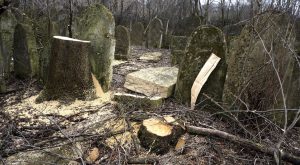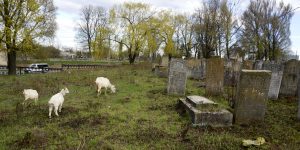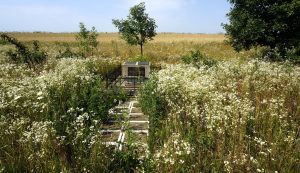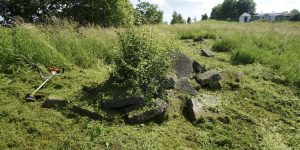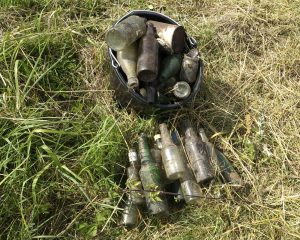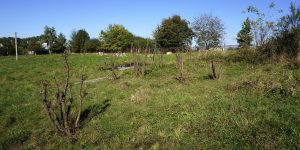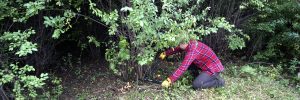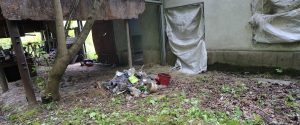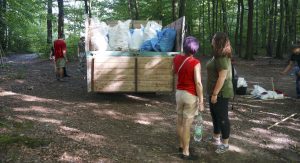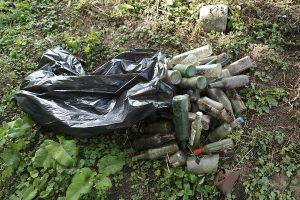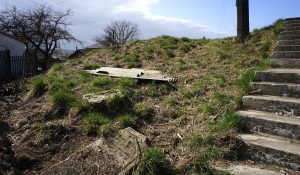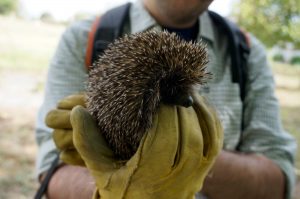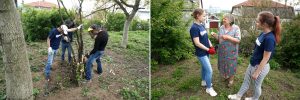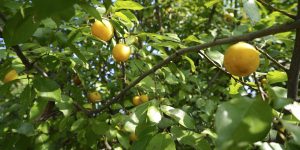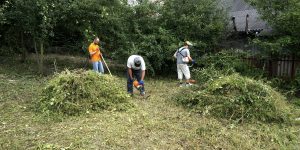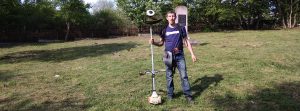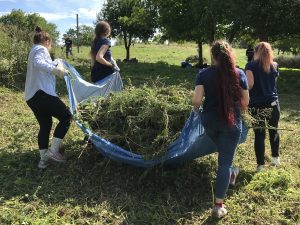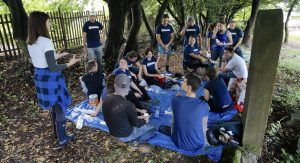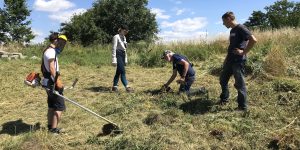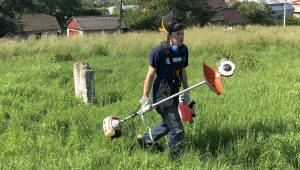![]() Ця сторінка також доступна українською.
Ця сторінка також доступна українською.
Introduction
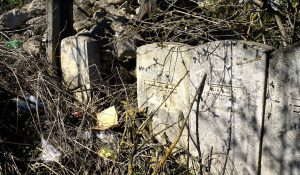
At the Jewish cemetery in Buchach (Ternopil oblast) before a major clearing and cleaning. Photo © RJH.
Controlling the growth of vegetation, especially wild grasses and shrubs, is one of the most important management tasks for heritage projects at Jewish cemeteries and mass graves in western Ukraine. First-time visitors to these sites, as well as virtual visitors viewing photographs of the places on the internet and elsewhere, often voice displeasure at the sight of overgrown vegetation which can almost completely obscure headstones (or the absence of headstones). Wild vegetation sometimes becomes so dense and tangled that visits to the sites are difficult, or even dangerous.
Managing vegetation at cemeteries is a global issue, with examples of runaway growth present at cemeteries both civil and religious, and of all faiths, in every country, even in places where vegetation is not a traditional feature of cemeteries, such as Israel. In western Ukraine, journalists and essayists frequently assess and report on the poor state of Christian cemeteries and the mass graves of wartime insurgents, but these issues are found everywhere, including in both urban and rural America. The problem is especially prevalent where cemeteries fall out of active use (either having reached capacity, or the community which established the cemetery has dwindled or disappeared) – this is of course the overwhelming issue for Jewish burial sites in western Ukraine. Controlling wild vegetation requires ongoing management, at least annually if not seasonally, plus a lot of hard work.
Two factors make it difficult to assemble brief but comprehensive advice for clearing wild vegetation from Jewish burial sites. First, the grounds and vegetation condition of cemeteries and mass graves varies tremendously across western Ukraine, as can be seen in photos from surveys of the places linked to the tables of identified Jewish burial sites on this website. The variation is even wider than these snapshots imply, because vegetation grows continuously; except for the rare landscaped sites, the condition of cemeteries and mass graves evolves every year, and can completely transform the type of care needed at a site in less than a decade’s time. Second, project leaders and volunteers come to the work with very different backgrounds, and may have either no prior experience working with gardens or tools, or years of garden and farm work managing plants, trees, common pests, etc. – but most people have some experience between these points, and may over- or under-estimate their skills and knowledge.

Wild brush and trees obscuring graves at the Jewish cemetery in Nyzhniv (Ivano-Frankivsk oblast) in late winter. Photo © RJH.
This page attempts to address a broad audience with both strategic and tactical advice from hands-on experience at typical Jewish burial sites in western Ukraine and beyond. One important subject not covered here is the selection and use of hand and power tools to aid cutting and clearing wild vegetation at cemeteries and mass graves. That subject is detailed on a lengthy companion page on this website specifically about tools; however, some guidance is given below for assembling tool collections for work groups of different sizes at common burial site types. The aim here is to provide strategies and guidance for inexperienced volunteers and leaders considering their first project; more experienced people may choose to skip some or many sections of this page, but we hope that skilled and knowledgeable people may also find something useful here. Further information well beyond these recommendations can be found on the references page on site clearing, cleaning, and reconditioning on this website, and in the case studies of vegetation clearing projects in the region and elsewhere.
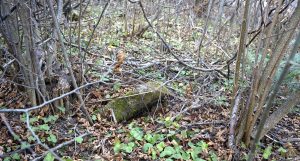
A broken headstone entangled in fast-growing trees in the Jewish cemetery of Stara Sil (Lviv oblast). Photo © RJH.
This page is long, with many topical sections following this introduction. The text below is bracketed at the beginning and end by sections with strategic and preparatory guidance but also includes solutions for a few specific practical problems; the sections may be read in any order:
- Strategies for Clearing and Cleaning a Seldom-Maintained Site
- The Art of (Averting) War
- Plan Ahead to Return Regularly
- Cleaning as an Essential Part of Site Rehabilitation
- What to Do with Waste Vegetation, Garbage, and Debris
- Annoyances and Hazards at the Burial Sites
- Molehills & Ant Hills
- Resident and Visiting Wildlife at the Burial Site
- Halakha Applied to Burial Site Clearing
- Tool Sets for Different Working Situations
- Organizing for a Volunteer Clearing Event
Strategies for Clearing and Cleaning a Seldom-Maintained Site
There have been very few projects organized to manage vegetation at Jewish burial sites in western Ukraine; most Jewish cemeteries and mass graves in the region are wild places which show no signs of human intervention during recent decades. Some cemeteries, usually devoid of headstones, have been adapted by local people for grazing animals, which significantly controls wild grasses and fast-growing shrubs and vines, but in the recent past this informal practice has fallen off due to increasing urbanization. Efforts to fence Jewish cemeteries to “protect” them in recent years have blocked animal access to the sites, also accelerating plant growth. Mass graves are often located in rarely-visited forests or left alone as wild “islands” surrounded by agricultural fields. Thus, most heritage projects will face wild vegetation of many years’ growth as a substantial obstacle to rehabilitation and commemoration of the sites.
As for most heritage efforts at Jewish burial sites, vegetation management strategies should be developed based on findings during a preliminary assessment, and with an eye to the long-term sustainability of the work and the site. Initial assessments are valuable not only for sizing the site plus identifying the magnitude and mix of plants and trees in and around a cemetery or mass grave, but also to highlight and evaluate safety issues which may be present at the site, and features which should be carefully worked around to avoid damage, such as useful trees and plants as well as headstones and other memorial markers. Walkover surveys also give important first reviews of the amount and types of garbage and debris present, which help to plan the sequence of cleaning and vegetation clearing work, and the type of labor and supplies needed for the cleaning.
If the preliminary assessment is sufficiently detailed to develop a full project plan including what plants and trees should be retained as part of future landscape designs, a reasonable clearing strategy will map the useful vegetation and then thoroughly clear the site over (usually) many days of work, removing all nonessential wild vegetation from one side of the site to the end. Where the initial survey reveals high shrubs and grasses, large numbers of trees with dense undergrowth, or other visibility limitations, usually some form of exploratory clearing is most useful to start, selectively removing plants and low tree branches with loppers and saws until the full extent of the wild vegetation is understood. Often simply untangling and dragging away fallen branches plus concrete and metal debris is a good way to expose the living vegetation for better study. Careful probing of a site with hand tools (for shrubs and trees) and string on powered brushcutters (i.e. no metal blades) minimizes irreversible plant injury as well as damage to unseen headstones, fences, etc.

Sometimes the vegetation is so thick it’s hard to know where to start.
Volunteers working at the Jewish mass grave near Rudky. Photo © RJH.
The overall strategy for clearing and cleaning a site will depend on the extent and mixture of wild vegetation and on the number and types of inanimate objects (e.g. headstones and construction waste), but a typical and efficient sequence with recommended tools is:
- untangling and dragging away fallen tree limbs and dead shrubs (gloved hands)
- pruning live tree branches which are attached low on the trunk (loppers and hand saw, or chainsaw, followed by gloved hands)
- mowing long grasses and light shrubs (brushcutter with string head, followed by rake)
- removal of garbage, construction waste, and other debris (gloved hands)
- felling unwanted individual shrubs and small trees by close-cutting flush to the ground (loppers and hand saw, or chainsaw, followed by gloved hand)
- close-cutting thick brush patches which were incompletely cleared with string (brushcutter with blade head, followed by rake)
This approach sequences the steps and tools to minimize damage due to unseen obstacles and to use the tools where and when they are most effective. For example, it is difficult to wield large brushcutters around knee- and waist-high tree branches. Also, brushcutter blades are useful for medium-weight vegetation only; they clear light grasses and thick or hard shrubs very poorly. Power tools with metal blades are easily damaged or disabled when striking unseen stone and concrete. Often multiple passes through the sequence of steps above are needed to progressively remove unwanted vegetation and garbage, open up visibility to organic and inorganic features of the site, suppress fast-growing trees and large shrubs, and expose half-buried headstones and discarded objects of all types.
The importance of cutting small trees and heavy shrubs flush to or below the ground surface at the burial site cannot be over-emphasized; failing to do this is a mistake most Jewish heritage projects and nearly all volunteers make in the first clearing projects they undertake, and the resulting problems can last for years. Woody stumps of less than two centimeters in diameter and standing less than two centimeters above the soil become a trip hazard for workers and visitors as soon as grass grows taller than that height and obscures the stumps. For stumps of two centimeters diameter or larger, when new growth sprouts from the stump, it is impossible to cut and clear the growth with a knife blade on a brushcutter, because the protruding stump is too hard for the blade to tear through and the blade or the brushcutter head can be damaged by the high-speed impact. Only trimming string is effective in this situation, and the plastic string may be rapidly broken by the protruding stump (less disabling than knife blade damage, but managing the breakage is tedious and wasteful of time and materials).
The only solution to this problem is attention and careful cutting of the plant or tree with loppers, a reciprocating saw, or a chainsaw, pressed against or into the cemetery soil to ensure no part of the remaining stump will protrude above the ground. It is very important to make the flush cut at the time the plant or tree is felled, if not during the felling cut then immediately thereafter as a finishing cut. As soon as a worker steps away from a short stump, it becomes nearly invisible from standing eye level among the mixed grass, brush, and cut vegetation which typically covers the ground when a cemetery or mass grave is an active work site. If the worker is not equipped to cut the stump flush to the ground when felling the shrub or tree, it is best to leave the plant trunk tall (0.5m or more) so it can be easily located and properly cut by another worker later. Although this approach is tedious, it can save considerable time overall in addition to making the burial site safer for all.
When many small stumps are already present at a burial site, the best times of year to find and cut them flush to the ground are early spring (before grasses begin to grow and hide the stumps) and just before or just after snows begin in late fall or early winter (when grasses and brush have died and become matted or rotten). Timing targeted work in these periods during western Ukraine’s typically unpredictable seasons is difficult. Small stumps can of course be cut in any of the usual working seasons, but it is inefficient to flag and cut stumps while doing large-scale clearing work.
The Art of (Averting) War
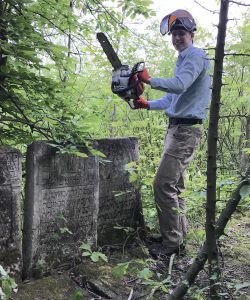
A little fun with a chainsaw before careful trimming at the Jewish mass grave near Rudky (Lviv oblast). Photo © RJH.
Controlling wild vegetation at Jewish burial sites is a demanding physical activity that often involves strenuous cutting and mowing of grasses, brush, and trees, often down to the ground; much of the work is done on hands and knees, in close struggle with the vegetation. It is easy to think of the activity as a kind of war, and during clearing events with groups of volunteers one often hears battle terminology used in discussions about the work. However, fighting is a poor analogy for vegetation management at cemeteries and mass grave sites, and if we characterize wild plants as “the enemy”, then we should take to heart what the legendary Chinese military strategist Sun Tzu said in the ancient treatise, The Art of War: “The supreme art is to subdue the enemy without fighting.” (Ch.3, para.4) Anyone who works at a burial site through three growing seasons of a year, and especially over several years, knows well that wild vegetation control is not a war which can be “won”.
It is especially important to be mindful of the long-term objective when approaching a clearing project the first time. “Clearing” may not be the best short- or long-term goal; “pruning”, “thinning”, or “trimming” might be better, and it is rare that a single strategy works well for all of the types of vegetation in a cemetery or at a mass grave. Consideration of the future impact of current cutting work is important. For example, the root networks of wild grasses hold soil together and help to resist soil erosion from heavy rains – a much more difficult problem to solve and restore than dealing with “weeds”. The leaf canopy of a grove of trees provides much-needed shade to visitors (and workers) in summer months, and slows or prevents the growth of many types of grasses and brush throughout the year. Any cutting of common wild plants and trees provides an opportunity for other perhaps less-desirable plants to establish themselves. A useful tree cut down in error may not be replaced through natural processes for decades, or ever. Herbicides used to relieve the physical work of mowing grass and brush may significantly destroy local insect populations and the animals which feed on them, impacting the beneficial work those insects do in pollinating plants in neighboring gardens or agricultural fields. Cemeteries often serve as important components of ecosystems in urban landscapes, providing food and shelter to local and migratory wildlife, and plants are widely recognized for their role in encouraging contemplation and solace in human visitors.
Thus, strategies for managing wild vegetation at a burial site should avoid indiscriminate or complete removal of any of the plant elements of the space before an overall plan for the site is developed and evaluated and resources are identified to implement the plan. Until then, vegetation removal should be selective, and focused primarily on the health of the site and the protection of existing built heritage structures (headstones, memorials, fences, etc.). These strategies should be communicated clearly to all workers joining vegetation clearing projects at the site to prevent a battle mentality from driving potentially destructive activity.
Plan Ahead to Return Regularly
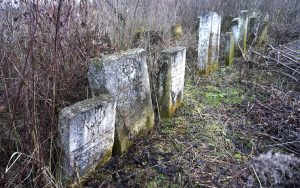
The Jewish cemetery of Shchyrets (Lviv oblast) very overgrown despite one full and one partial clearing a few years before. Photo © RJH.
The guide section on burial site and project sustainability on this website illustrates the never-ending demand which nature puts on site managers until a landscaping plan to control (i.e. slow) growth can be implemented. Almost every Jewish burial site in western Ukraine visually demonstrates a need for cleaning and clearing vegetation, and this is equally true at sites which have been occasionally cleared. All of the brush and small trees which are removed from a cemetery in one year will typically return over the next few years – and tall grasses often return in less than one year. Visitors to Jewish cemeteries in the region have documented some sites being “reclaimed by nature” and “becoming a jungle” in a short time. Absent a commitment to return to a cleared site year after year, any cemetery or mass grave will soon revert to its earlier state.
This issue should guide not only the planning and funding of regular work at the site, but also the strategy for acquiring hand and power tools, consumable supplies, and other resources to support the work. At somewhat higher initial cost, purchasing higher-quality tools which can be easily maintained for endurance, and replaced less often, can result in greater long-term economy. Thus the first clearing event can be viewed as an investment in the long-term health of the site, and hopefully one of many such events over a period of years.
The cemetery and mass grave projects in Bolekhiv (Ivano-Frankivsk oblast), as summarized in case study 06 on this website, are an example of this type of long-term commitment to vegetation control, using local managers and foreign funding to perform a thorough initial clearing of the sites followed by less intense routine vegetation control in subsequent years. Experience working at the four Jewish burial sites in Rohatyn (also in Ivano-Frankivsk oblast) over four years, one of which is detailed in case study 05 on this website, reinforces the importance of returning after initial clearing projects.

Two cycles of growth and clearing during summer 2020 at the old Jewish cemetery of Rohatyn; more cycles followed the same year. Photos © RJH.
Cleaning as an Essential Part of Site Rehabilitation

Clearing garbage and debris from the mass graves near Ralivka (Lviv oblast) and the new cemetery in Rohatyn
(Ivano-Frankivsk oblast). Photos RJH.
A key part of making Jewish cemeteries and mass graves safe and comfortable for visitors is cleaning the sites, i.e. removing all forms of deposited waste from the burial sites: household garbage, garden and landscaping debris, construction rubble, stones, excess and disused concrete, bottles and cans, wire and cable, and plastic debris. Cleaning the sites also make them safer for volunteers and other workers, who typically walk and kneel over the entire site during their work. Some types of garbage and debris seen at a number of seldom-visited Jewish burial sites in western Ukraine are potentially quite dangerous, including rusted and sharp metal waste, broken window and bottle glass, used hypodermic needles, used condoms, rotting food waste, human excrement, and liquid and solid chemicals (pesticides, fertilizers, paint, etc.). This is an ugly but serious issue, though fortunately most of the garbage and debris found at Jewish burial sites in the region is benign and merely annoying. Collecting and removing these foreign materials is included in the typical sequence of clearing and cleaning tasks listed above, but it can also be a useful site rehabilitation task on its own, even without vegetation clearing.
As in many parts of the world, even in stronger economies, cemeteries and any parcel of land in Ukraine away from town centers (i.e. without frequent pedestrian traffic) become potential dumping grounds for garbage and debris, to avoid the costs for proper disposal. If there are few parks and campsites in the area, cemeteries and mass grave sites may also serve for informal and illicit recreation, especially parties, cooking and eating, and drinking; all of these activities produce waste which is seldom removed from the site by the participants. Cemetery neighbors nearly always frown on these behaviors and the waste which is left behind, but usually are powerless to stop the activity themselves.
One of the most important supplies brought to any Jewish cemetery or mass grave clearing event is rolls of large and very heavy-duty garbage bags; sometimes inexpensive construction waste bags normally used to collect and transport mixed and masonry rubble are useful as well. It is hard to anticipate in advance how many such bags will be needed on a given work day, so it is best to bring what seems to be too many; if not used on the first day, they will be used on another.
Some debris gathered at burial sites will be simply too large, heavy, or sharp to carry in garbage or construction bags; these items may need to be moved by hand or wheelbarrow and transported away by truck. Of course all garbage and debris should be gathered using sturdy gloves to protect hands against cuts and puncture wounds; in some cases extra hand and arm protection from wrapped shirts or rags may be warranted.
An important corresponding benefit of cleaning a Jewish burial site of garbage and debris derives from the visual clue that the cemetery or mass grave matters to and is cared for by people in the area. Like clearing vegetation and other project aspects which change the appearance of the site from one of abandonment and neglect to one of interest and concern, removing garbage alerts locals and passersby that a cemetery or mass grave is attended, and has both spiritual and heritage value to someone nearby. This visual change by itself has caused a noticeable reduction in the occasional depositing of garbage and debris at some Jewish burial sites in western Ukraine.
What to Do with Waste Vegetation, Garbage, and Debris
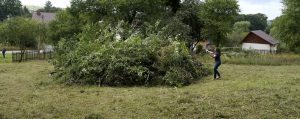
A huge pile of cut vegetation at the new cemetery in Rohatyn (Ivano-Frankivsk oblast)
during an extended clearing project. Photo © RJH.
Any cemetery clearing effort creates a huge amount of cut vegetation, most which is unusable as firewood, mulch, or for any other secondary purpose. Some of the cut material will naturally decay at the site in a season or a year, but thicker, drier, and harder plant materials, if they cannot be repurposed, must be disposed of offsite. In some cases the amount of cut thick grasses is also too much for natural decay without causing the vegetation beneath it to rot, so this grass (or at least some of it) must also be taken away for disposal.
Burning waste vegetation at the burial site or elsewhere is rarely advisable. The smoke produced by burning is noxious to cemetery neighbors, and there are laws in Ukraine to prohibit burning of waste in residential and other areas. Annual burning of agricultural fields before planting or after harvesting is a persistent tradition in western Ukraine, despite scientific advice against it on agricultural production grounds and government opposition on health and economic grounds; this public conflict has sharpened opposition to casual waste burning in many communities.

Gathering cut grass and brush at the Jewish cemetery of Kalush (Ivano-Frankivsk oblast). Photo © RJH.
A few burial site heritage projects may be able to engage the local municipality to assist with the removal and processing of cut vegetation. Some towns and cities are large enough to have their own powered wood chippers to shred large branches and mixed vegetation into usable mulch, and some also have contracts with truckers and disposal sites where unusable waste materials can be deposited. In the absence of local support, heritage project leaders will have to arrange for hired trucks to transport the material to fields where the vegetation can be deposited for long-term natural decay, usually for a fee to the landowner. It is normally wise to separate and cut tree trunks and larger branches to manageable lengths so that the wood can be split and used for firewood; cemetery neighbors and others with wood-burning furnaces and stoves may welcome a gift of wood for their personal use.
Garbage, construction debris, and other non-plant waste usually must be removed to a landfill. Sometimes the local municipality can assist with this, but usually the project leaders must make arrangements themselves. Small amounts of inorganic waste can be removed to community waste containers, but larger amounts should be taken by car or truck to a public or private landfill, and deposited at project expense. Some items with recycle or reuse value may be scavenged from non-plant waste and left for informal reclamation; a review of common practice at waste and recycling containers in the area will usually identify what may be of value to others.
Annoyances and Hazards at the Burial Sites
In addition to garbage and debris as described above, vegetation clearing project leaders should be attentive to a number of other annoyances and potentially-dangerous encounters which are possible in Jewish cemetery and mass grave work in western Ukraine. Several of these hazards are clear and may need only this list of reminders; a few will be discussed in more detail below the list:
- uneven ground and hidden objects (including fragments of headstones): risks of stumbling and falling, sprained ankles, broken bones
- rusty cans and wire, broken bottles and plate glass: risks of skin cuts and infection
- asbestos roofing panels or other poisonous materials and objects: risk of life-threatening illness
- lifting and carrying heavy objects: risks of lower back pain or injury, and arm and leg injuries
- hot and humid work days: risks of heat illness and related health and comfort stresses
- spiny and thorny plants: risks from cuts, spines, and irritation by stinging nettle, thistle, wild roses, and some large shrubs
- poisonous plants: risks of skin damage and scarring from a toxic chemical in giant hogweed (locally known as borshchivnyk)
- dangerous stinging and biting insects: risk of disease from ticks and mosquitoes
- other biting animals: risk of poison or serious illness from venomous snakes and diseased small mammals
Although first aid kits and training can mitigate the effects of some of these problems, it is of course far better to try to prevent them from occurring through protection and avoidance. Project leaders should always provide thick and durable gloves to protect the hands of every volunteer at the site, but all workers regardless of the tasks they expect to take up should bring and wear their own strong protective clothing, especially sturdy shoes or boots.
Common annoying plants found in wild growth in Jewish cemeteries and mass grave sites in western Ukraine, such as stinging nettle and wild roses or other thorny plants, are relatively harmless; scratches from thorns heal quickly if the wounds are cleaned soon after breaking skin, and the sting from spiny hairs of nettle usually dissipates after about a day; wearing heavy gloves and a long-sleeved shirt while working in and around the plants will provide some protection, but large and dry thorns can poke through any clothing or glove so are better handled with tools.
Sosnowsky’s hogweed (Heracleum sosnowskyi) is a large invasive plant which presents a very significant risk to people working at semi-wild burial sites across western Ukraine (and beyond); special attention and training for all new volunteers at a site is highly recommended. The plant is easy to recognize, though sometimes mistaken for a similar-looking but harmless smaller species; when in doubt, it is better to avoid any similar-looking plant. Sap from any part of the hogweed plant destroys natural skin protection from solar radiation, so that skin at contact points suffers serious inflammation including burns, blisters, or worse after even light sun exposure. Mild contact with the plant takes several weeks or more of recovery; serious contact leaves permanent scars. Control of the plant requires very careful cutting of the stem well below the ground surface; a best practices manual on control of the dangerous Heracleum species has been developed and published freely by an international team of researchers; it includes guidance on identification, health and safety advice, and methods for eradicating the pest.

Large hogweed plants at a Jewish mass grave in Rohatyn (Ivano-Frankivsk oblast); skin damage from a prior encounter with the plants; a shovel sharpened to use as a blade;
the carefully-cut plants laid out to dry at the site. Photos © RJH.
Otherwise, the risks while managing vegetation and other grounds work in Jewish cemeteries and mass grave sites are typical of work outdoors in rough landscapes, and ordinary attention and caution will provide reasonable if not complete protection.
Molehills & Ant Hills
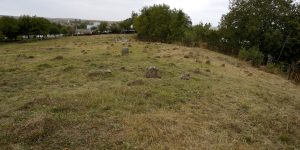
Vegetation management reveals more molehills than headstones in the old Jewish cemetery of Rohatyn. Photo © RJH.
Cemeteries and mass grave sites which are mostly open (grassy, with few trees and little leafy ground cover) tend to “grow” molehills (and derivative ant hills) over time. The hills, which usually entangle grass roots and other small tenacious plants, are unsightly; worse, they present both a trip hazard when surrounding grasses are high and an annoying obstacle to brushcutters equipped with both string heads and steel blades.
Unfortunately, there are no known effective molehill or ant hill removal strategies, tools, or techniques. If a molehill or ant hill sits above an abandoned tunnel site, the hill can be cut and spread with a sharp shovel, or kicked flat with a heavy boot, and the hill will remain flattened. But if there are live animals in an extended underground burrow or ant colony, destroying a hill entrance will usually spur the creatures to use a hill at another entrance, and to build more entrances and hills. As the moles, voles, and ants which build the hills are not otherwise harmful to plants in the burial sites, killing the animals as a remedy for the hills is not advised (and often not effective or without harmful side effects to human and other burial site visitors).
When more and/or better information and guidance is available to address the problems of molehills and ant hills at Jewish burial sites, those methods will be detailed in the supplemental technical section on this website.
Resident and Visiting Wildlife at the Burial Site
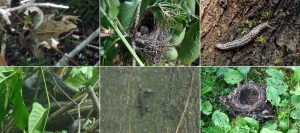
A small sample of wildlife encountered during clearing projects at regional Jewish cemeteries. Photos © RJH.
Despite the special attention given to stinging and poisonous plants, biting insects and animals, and some burrowing mammals in the sections above, most of the resident and visiting wildlife at Jewish cemeteries and mass graves in western Ukraine is benign, and some actually beneficial to the grounds in and around the burial sites. There is more information about typical plants and animals found in the natural landscapes of the region’s semi-wild Jewish burial sites in the guide page on landscape planning and development on this website, so here we will only mention the types of encounters and issues which may arise during cleaning and vegetation management work at the sites.
Wild plants and animals of course ignore cemetery and mass grave boundaries, often even those which are fenced or walled to restrict human access. Whatever wildlife is present in the surrounding landscapes will explore Jewish burial sites as sources of food and shelter, and some will take root or make homes there. A cemetery which has not been managed for some years develops a mature mixed growth of grasses, fungi, brush, vines, and trees, which in turn supports insects, birds, reptiles and amphibians, and small mammals. These animals normally hide from view for safety, but thinning or clearing vegetation often reveals evidence of their presence and sometimes the creatures themselves. Encounters are inevitable, but reactions are personal; every project leader should consider in advance what to do when these encounters happen, and communicate that approach to others working at the site.
Evidence of animals in Jewish cemeteries in and near western Ukraine in recent years include insects, frogs, lizards, bird nests (and many wild birds), wild bee hives, hedgehogs, squirrels, and more. Even if individual animals or their homes are protected during vegetation clearing work, the clearing will at least alter and may destroy the animals’ habitat and their sources of food. Some animals will remain and adapt to the changed environment, others will move or die.
Halakha Applied to Burial Site Clearing
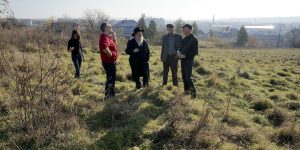
Regional leaders discussing options for rehabilitation of the old Jewish cemetery in Rohatyn. Photo © RJH.
The references page for project concepts on this website includes several resources which may be useful in understanding the relationship between Jewish religious law, or halakha, and the work undertaken to clear wild vegetation as part of the occasional care of Jewish burial sites. A subsection on Jewish law and tradition in cemeteries on the guide page for site surveys also provides important background to this topic. The essential approach of respect can helpfully guide approaches to clearing work in ways which honor the deceased, the site, the neighbors, and all of the communities which share the site.
A key point is that halakha is written and interpreted by Jews for Jews; its purpose is to guide the behavior of religious Jews in civil and religious life, as an extensive review of Jewish cemetery law makes clear. Non-Jews and secular Jews may choose to follow specific interpretations of halakha as a sign of respect while visiting or working at a Jewish cemetery, but if they do not, there is no “legal” violation (unless their behavior also violates local civil law). There is one “hard” rule applicable to everyone working at a Jewish burial site, plus several other Jewish traditions which should be considered by all, but there are also regional Christian traditions which should be considered when working at Jewish sites as well; each of these topics is detailed below. Each project leader and volunteer should consult with local religious leadership, if they can, and evaluate for themselves how to respect Jewish law and tradition during their work at a burial site.
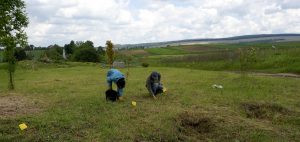
Researchers gathering scattered human remains for reburial at Rohatyn’s south mass grave. Photo © RJH.
The hard rule is against disturbing the remains of a deceased and buried Jew. This is expressed in the Jewish prohibition against exhumation (which is allowed only in the most extreme circumstances), and by common extension this often includes a general prohibition against disturbing (displacing) the ground over a Jewish grave. Fortunately there are few situations which arise during vegetation clearing work which make it difficult to adopt a simple “no digging” rule for the project. For example, it is rarely necessary to extract the stump of a tree or large shrub by pulling; instead the stump can be cut flush to the ground and left to rot over time.
Attitudes of respect also ground the remaining guidelines and restrictions applicable to work at Jewish burial sites. For example, the head coverings traditionally worn by religious male Jews applies in a cemetery and at a mass grave as elsewhere; clearing project leaders can choose to adopt the rule for all men working at a site regardless of their faith, but if so the leaders should be prepared to furnish comfortable utility caps to everyone participating, and to explain the origin of the tradition and its applicability at the site. Some project leaders may choose to prohibit eating meals and snacks within the perimeter of the burial site, but others view meals while working as separate from the category of recreational behavior, so allow food and non-alcoholic drinks. Many smokers who support Jewish cemetery clearing projects choose to step outside the cemetery perimeter when they use tobacco or e-cigarettes, but even some regional rabbis occasionally smoke within Jewish burial sites.
Work is traditionally suspended on the sabbath and on religious holidays in both Jewish and regional Christian communities. This creates some complexities for Jewish burial site clearing project leaders, as it effectively eliminates work days on both Saturday and Sunday (when many volunteers with weekday jobs would otherwise be available to help), and on significant holidays on the Hebrew calendar as well as the Julian or “Old” liturgical calendar used by most churches in western Ukraine. This means that combining Jewish and Christian calendars, almost 100 days, or about 40% of the eight months in the normally viable working seasons between April and November, are reserved for religious observation. Unscheduled events with religious significance such as funerals can also interrupt work at nearby Jewish burial sites, but should also be respected as silent time for good relations with the local community. Although not essential, it is very helpful for many reasons to have at least one worker present during cemetery work who is fluent in the Ukrainian language and familiar with local customs, to receive and communicate with neighbors around the burial site to explain the work and to listen to local concerns.
In many cases land ownership is often not well defined in western Ukraine (a legacy of the Soviet period), and land use is often arranged informally; kitchen gardening and animal grazing may be set up on cemeteries which appear abandoned, as for other apparently empty and undeveloped land parcels. Cemetery project leaders may consider applying only to themselves the halakhic rules against profit from the use of burial sites, to permit the locals to continue harvesting fruit from older trees in a cemetery, or to allow some ongoing animal grazing (which can work to control wild grasses and brush), and to give to site neighbors any downed wood which is suitable for heating. In these situations, and for the benefit of long-term care of the sites, it may be best to simply request that no new fruit trees be planted or animal tethers installed, and let the situation evolve until landscaping development begins.
Tool Sets for Different Working Situations
With the grounded experience (from research, discussion, and a lot of trial and error) of Jewish cemetery rehabilitation organizations such as The Matzevah Foundation, the Lviv Volunteer Center, and Rohatyn Jewish Heritage, we can outline a few suggested “minimum” tool sets to support vegetation clearing at typical Jewish burial sites seen across western Ukraine and the surrounding regions, tailored to the size of the working group. You can compare these tool sets to the detailed tool descriptions and advice on the companion technical resources page on this website.
All known current projects in the region struggle with the problem of acquiring and managing tools for “occasional” use at Jewish burial sites; it is difficult to justify purchasing, storing, and maintaining tools which may be used fewer than twenty times per year. The concept of sharing tools between sites and organizations makes good economic sense but is currently difficult to manage with few activists spread across a large geographic area. Investing in a small number of durable tools to use and maintain over a period of several or many years is effective, as demonstrated by the evolution of practices employed by the groups named above and others, but as the number of active projects in western Ukraine increases or opportunities to rent tools become more viable, other approaches should also be considered.
Suggestions for minimum or starting tool sets are:
For the “one man band”, i.e. a single worker with some prior experience:
- sturdy gloves – for handling vegetation, garbage, tools, and surprises
- heavy-duty large garbage bags – for collecting garbage and mixed debris
- a pair of long-handled loppers – for felling large shrubs, cutting vines, pruning larger trees, and general light to medium cutting
- a small hand pruning saw – for occasional large-limb cutting on trees, and felling the largest shrubs
- a medium-powered brushcutter with string and blade attachments – for general grass and brush work
- a small first-aid kit with known good antiseptics, small bandages, etc.
- plain water – for drinking, washing hands and wounds, and cleaning tools
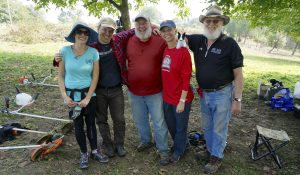
A small but experienced work crew. Photo © RJH.
For a small group of frequent co-workers with mixed experience:
- sturdy gloves – for handling vegetation, garbage, tools, and surprises
- heavy-duty large garbage bags – for collecting garbage and mixed debris
- a medium-sized tarp – to lay out tools and provide a clean place for rest
- two or more pairs of long-handled loppers – for felling large shrubs, cutting vines, pruning larger trees, and general light to medium cutting
- a small hand pruning saw – for occasional large-limb cutting on trees, and felling the largest shrubs
- one or two medium-powered brushcutters with string and blade attachments – for general grass and brush work
- one or more stiff metal garden rakes plus one or more lighter leaf and grass rake – to follow the brushcutters and light pruning work
- a small first-aid kit with known good antiseptics, small bandages, etc.
- plain water – for drinking, washing hands and wounds, and cleaning tools
For larger volunteer groups with a few very experienced crew members:
- sturdy gloves – for handling vegetation, garbage, tools, and surprises
- heavy-duty large garbage bags – for collecting garbage and mixed debris
- one or more large-sized tarps – to gather cut vegetation, lay out tools, and provide a clean place for rest
- several or many long-handled loppers – for felling large shrubs, cutting vines, pruning larger trees, and general light to medium cutting
- two or more small hand pruning saws – for occasional large-limb cutting on trees, and felling the largest shrubs
- two or more medium-powered brushcutters with string and blade attachments – for general grass and brush work
- two or more stiff metal garden rakes plus two or more lighter leaf and grass rakes – to follow the brushcutters and light pruning work
- one large hand saw, or one heavy-duty reciprocating saw or small chainsaw – to make quicker work of occasional heavier woodcutting chores and a few specialized tasks
- one sharpened shovel – for occasional cutting of soft plants plus moving thorny or poisonous cuttings
- a large first-aid kit with known good antiseptics, small bandages, etc.
- plain water – for drinking, washing hands and wounds, and cleaning tools
Each of the power tools listed above also require several associated personal protective items plus consumable supplies (e.g. fuel, motor oil, trimming string) and replacement blades, etc. All of the hand and powered cutting tools also need a few sharpening and adjusting tools onsite to keep them working effectively.
At some sites, for example cemeteries or mass graves with heavy mature trees, larger or several motor saws may be appropriate, but those tools should be restricted to use by experienced workers. An assessment of the need for more or larger saws can be made during the first days of work.
The lists above highlight some overall tool guidelines for all projects regardless of work group size:
- every project needs high-quality sturdy gloves and heavy-duty garbage bags – every worker, even the least experienced, can and should use these at every site type
- loppers are the most important tool in the cemetery – for pruning and trimming the most common medium-weight shrubs, trees, and vines
- a brushcutter sized for landscaping work (larger than common household garden tools) able to work with both string and blade heads can manage a wide range of grasses, brush, and slight shrubs, including delicate work around headstones and grinding through thick matted growth
- inexpensive unpowered hand saws can manage nearly every task that chainsaws are often used for, more safely and with far less maintenance, although the effort in using them is much greater
For further details and advice about each of these tools plus some alternates for consideration, see the vegetation clearing tools page on this website.
Organizing for a Volunteer Clearing Event
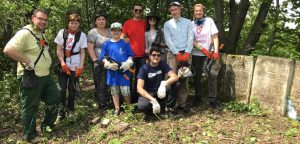
A small mixed working group organized by the Lviv Volunteer Center to clear at the Rudky mass grave memorial. Photo © RJH.
All of the work involved in cleaning and clearing vegetation at Jewish burial sites is labor-intensive, but most of it requires very little prior training or experience. The work is thus a good match for occasional volunteers of all ages, so long as their health and mobility are good. Skilled and experienced workers can train some volunteers to perform a wider variety of tasks while onsite, with appropriate oversight to ensure the volunteers’ safety and to minimize damage to the site from misunderstanding and inexperience. However, at typical western Ukrainian Jewish cemeteries and mass graves which have not recently been managed, half or more of the most important work in clearing vegetation needs no tools other than a good pair of gloves and the volunteers’ hands.
Organizing a volunteer clearing event involves arranging much more than tools and supplies. Considerations in advance of an event include:
- identifying transportation routes or setting up transport means for all workers
- identifying language interpreters within the volunteer group, or arranging a separate interpreter to remain on the site and with the workers through each work day
- gathering or arranging adequate food and water for all workers, allowing for individual dietary needs (e.g. kosher, vegetarian, etc.)
- identifying or providing water and access to toilets near the burial site
- identifying shade points on hot days and covered shelter points on damp days
- identifying resources for medical assistance in case of accidents
- arranging lodging for workers (for a multi-day work event)
While onsite with the volunteers but before starting work, project leaders should meet with the entire working group to:
- explain the history of the site and the associated community, before, during, and after WWII
- explain the purpose of the project and outline the day’s goals
- outline guidance on behavior to show respect for the site and the local community
- review safety guidelines in general and for specific types of work
- inquire about each volunteer’s preferences for types of work and any concerns they may have
- identify the most experienced workers who may be approached at any time for guidance in tool use or work methods
A similar but shorter group meeting is helpful at the end of the day, to gather impressions and suggestions, and to discuss any issues which arose during the work or elsewhere.
During the course of the day, more experienced workers will be required to check and maintain all of the tools, to monitor the health and safety of the volunteers, to offer suggestions and advice to less-experienced workers, and to adapt to any issues which may arise. It can be helpful to divide volunteers into groups using like tools, and in each group to have a brief technical and safety discussion led by an experienced participant before starting work, to remind the others for example about the maximum stem cutting diameter for loppers, or the negative impact of running power tool engines continuously at high speed.
Experience with past large volunteer clearing projects conducted at Jewish cemeteries and mass graves in western Ukraine and central and eastern Poland suggests that an effective work day during summer and fall seasons is about 5 to 6 hours long, with additional time at each end of the day for unpacking and repacking tools, gathering and disposing garbage, and general site management. During each work day, both workers and power tools need frequent breaks to cool off and rest; the work is hard and heavy, so even skilled and energetic people and durable machines suffer if they do not pause for at least 10 minutes about every half hour. A rule of thumb used by some project leaders is to alternate operators each time a power tool needs refueling, and to let the tool rest for 10 minutes before resuming work after refueling. This approach diminishes the effective work time of both the volunteers and the tools, but helps to prevent heat illnesses and equipment malfunctions, and extends the life of the tools. The need for breaks is even greater for inexperienced and older workers, and those volunteers should especially be encouraged to rest often.
It is impossible to estimate how many volunteers and how much time will be needed to effectively clear a given burial site in a particular season – it is difficult to predict progress at an individual site even from one day to the next. For example, common issues such as rain can slow or stop work altogether for a few hours, a day, or as in 2020, weeks at a time (it is ineffective, uncomfortable, and sometimes dangerous to try to clear vegetation in the rain). Following more than 50 days working at a few typical Jewish burial sites in western Ukraine in recent years, by mixed groups of skilled and relatively new workers in different seasons, we can roughly estimate that a skilled worker with a brushcutter can clear 500 to 1000 square meters of moderate brush and grass in one day, if there are no major obstacles, there are adequate supplies and tool support, and the site has a typical wild mix of plants. With high skills, a long work day of 8 or more hours, relatively young wild vegetation at the site, and full rest the day after, a worker may sometimes be able to double that progress in one day. Clearing rates for woody shrubs and trees cannot be estimated in advance at all, even with experience.
Setting vegetation clearing progress goals for group volunteer events should probably be very flexible, if not simply abandoned in favor of broader objectives. First-time and inexperienced volunteers are usually inefficient workers, but they bring interest and curiosity as well as a desire to bridge cultures, which have long-lasting benefits to the cemetery project and its larger goals. It can be very valuable to introduce volunteers from out of the area to the Jewish and other heritage of the town where the work will be done, even though these casual tours take workers away from the burial site for a while. Developing an interest in a Jewish cemetery or mass grave among active people in local and international communities provides rewards to a project well beyond the short-term; first-time volunteers may return with greater skills to work again at the same site or others, and many become long-term ambassadors for a project and for regional Jewish heritage in general.

